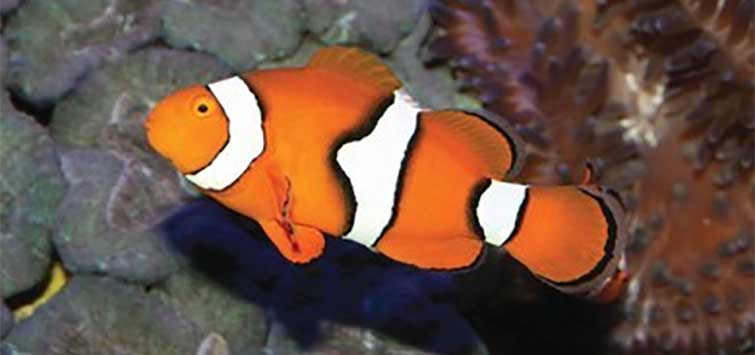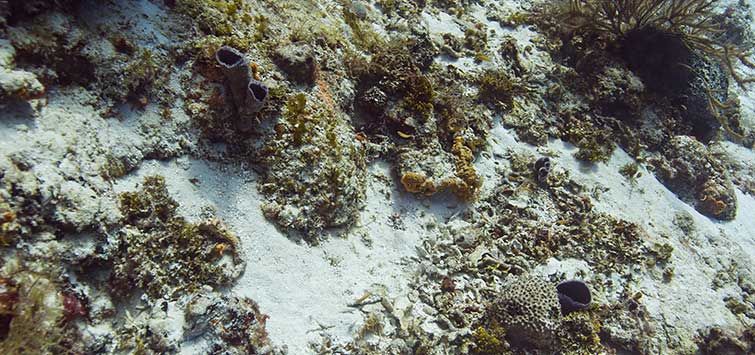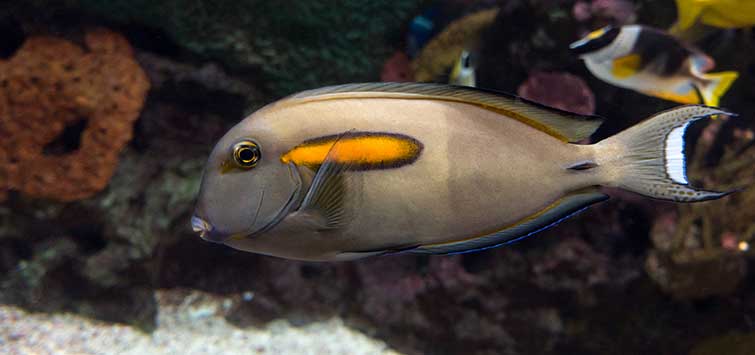Adapting to the Times: The Evolution of a Reef System
Author: Iggy Tavares, PhD
From a fish-only tank to a full-blown reef system, two marine aquarists have learned what it takes to grow both their aquarium and their hobby.
Al and Karen Schreiber, members of the Orlando Reef Caretakers Association (ORCA), kindly agreed to the visit that David Hill kindly organized for me when I was in Orlando recently attending a conference.
A History with Marines
Al and Karen are both experienced marine hobbyists. Al started out in the early 1980s in New Orleans with a 29-gallon tank donated by a neighbor, which came with an undergravel filter, red sponge, shrimp, and a couple of dwarf angelfish (flame and coral beauty). He quickly learned about the nitrogen cycle after losing an angel to ich.
By the late 1980s, Al, together with Karen, moved up to a 75-gallon tank they originally stocked with fish only. It was fitted with a wet/dry filtration unit that efficiently removed ammonia and nitrites, but they found that they had a buildup of nitrates over time. When they started introducing large-polyp stony (LPS) corals and soft corals, they began using an overflow system to skim the water surface and a sugar-driven nitrate reactor to reduce the nitrates. They began adding live reef rock, and things went well for a whole year.
Algae Sneaks in
Then, unbeknownst to them, the rocks became saturated with phosphates and almost overnight their tank turned into a green glob of algae. A reverse osmosis and deionization (RODI) system that they eventually purchased helped solve the problem.
The Upgrade
In the early 1990s, Al and Karen upgraded to a 110-gallon tank that was fitted with all the technology they acquired along the way. They decided to use the Berlin method of reef aquarium filtration, which involved using live rock as the primary source of biological filtration. At the time, this was considered to be the end-all of the marine aquarium hobby. New, very-high-output (VHO) fluorescent lighting allowed them to expand their setup into a full-blown LPS and soft coral tank. This proved to be a great tank that worked well for many years, so much so that they had a lot of visitors come to see it, which encouraged them to share their experiences by forming a club.
A Larger Setup
In the mid-1990s, after taking a job transfer to central Florida, Al and Karen lost touch with the hobby for a few years. After a second move to a new home, they started up their current tank in 2003. Measuring at 210 gallons (72 x 28 x 24 inches), this was almost twice as big as their previous tank, and it was set up with a lot of light from three 250-watt metal halides and three 6-foot VHO fluorescent tubes. Additional equipment included a custom-built sump and some chillers, a skimmer, an ozone unit, and a dosing unit for additives, while a RODI unit provided ultra-pure water for making up the marine water mix. On a 3- to 4-inch sandbed, a heavy load of live rock was laid that gradually got covered with colorful LPS and soft corals.
The tank really did flourish, so much so that by 2006, it was necessary to begin pulling coral frags from the tank. In particular, a purple and green toadstool leather coral grew exponentially and filled a third of the large tank. The conundrum was how to frag such a large coral piece. Through joining their local reef club, ORCA, they were introduced to a local fish store that worked with Al to cut the huge, colorful leather coral into 60 frags, which still left a very large host colony of the leather coral. One highlight of 2007 was Al and Karen winning the ORCA Tank of the Year award.
Fixing a Setback
Al and Karen started working with small-polyp stony (SPS) corals in 2008, and things went well for a couple of years. The tank began to diminish in mid-2010, however, as once-flourishing corals began falling back. Despite the increased frequency of the 25-percent water changes (up to 60 gallons each time), they continued to lose fish with no obvious explanation for the losses. New, healthy-looking fish would only survive a few days. Additionally, algae and cyanobacteria began to take hold in the tank, which was rather distressing.
After some extensive reading and talking to fellow ORCA club members, they were convinced that they were dealing with a heavy concentration of dissolved organics producing phosphates in the sandbed that had been relatively undisturbed for seven years. They tried to clean the sandbed, but as it was a rather deep tank (28 inches) filled with live rock and corals, this proved rather difficult.
Karen offered to help Al break the tank down to remove the sandbed, which was the incentive that he needed. Removing the corals, rock, and then the sand made for a very long day. The rocks were scrubbed and cleaned first in pure water and then in clean salt water before re-assembly.
This time they decided to go for a bare-bottomed tank with no sandbed. Hence, the rocks were now placed directly on the clean bottom of the tank and then stacked on top of each other. The rock load was also reduced by some 20 percent to allow more water movement and to provide more space for corals and fish. The sump was loaded with phosphate remover to absorb any phosphates leaching out of the rocks. They slowly introduced some herbivores (tangs) that did really well with no more losses. The clean rock began to turn green, but adding more herbivores (crabs, urchins, and more fish) took care of that problem. The tank thankfully began to flourish once again.
Going Green
Following the overhaul of their aquarium, Al and Karen started looking at ways on how to cut back on the use of electricity because of the continually rising high costs. The largest consumption of electricity was from the metal halide lighting, so they started looking seriously at light-emitting-diode (LED) lighting. Their research suggested that one of the many advantages of LED lights was that they were reputed to have a very long life span (about 50,000 hours) without any decline in quality, which meant they could last for 10 years. Some LED units were reputed to provide photosynthetically active radiation (PAR) readings comparable to metal halide with light wavelengths that were fully absorbed by corals, resulting in very good growth. More importantly, these LED units used just 20 percent of the electricity of the equivalent metal halide unit and produced very little heat.
Water Parameters
pH: 8.1
Alkalinity: 3.4 meq/l, about 10 dkh
Salinity: 1.025
Mg: 1440
Ca: 430
K 20: (working to get higher)
NO3: None
NO4: None
NH4: None
PO4: Currently 0.00–0.01. During meltdown, 0.04.
Temperature: 79°F
The light changes were transitioned overnight, and there were no noticeable or visible adverse reactions exhibited by the corals when LEDs came on instead of metal halides. Over the first weeks, the SPS continued to show nice growth, and the LPS seemed to open slightly more under the LEDs.
A Thriving System
During my visit, the Schreiber’s aquarium looked wonderful under the new LED lighting system that Al had installed some two weeks before. The aquarium held a large number of large, colorful LPS and some SPS corals, all of which were showing full color. The collection of LPS corals with diverse shape, form, and color included boulder brain coral Colpophyllia natans, maze coral Platygyra sp., doughnut coral Scolymia sp., Blastomussa coral, hammer coral Euphyllia ancora, torch coral E. glabrescens, elegance coral Catalaphyllia jardinei, and several Lobophyllia corals.
Corals
The SPS corals included a large staghorn acropora Acropora cervicornis, Oregon tortuosa A. tortuosa, and green plate coral Montipora sp.
Fish
Color and motion was added to this reef by a gold ring surgeonfish Ctenochaetus strigosus, a small Pacific blue tang Paracanthurus hepatus, a yellow tang Zebrasoma flavescens, a pair of clownfish Amphiprion ocellaris, and a blue neon goby Stiphodon atropurpureus. It was interesting to see that there were two cleaning stations in the aquarium. One was manned by the blue neon goby, which used the large boulder brain coral as its base, and the other by a blood red shrimp Lysmata debelius, which had a hideaway among the live rock. All the tangs, particularly the small regal tang, made full use of both cleaners and allowed them to hop on to do their job.
Lighting
Changing from metal halide and VHO fluorescent to LED lighting has had several benefits. The wattage for lighting the aquarium has dropped from 1100 watts to just 300 watts for the 10 hours it is turned on per day. As the LEDs produce negligible heat, the aquarium water temperature is now more stable, with the aquarium chiller unit kicking in a lot less to maintain the ideal aquarium temperature of around 79°F. Rather importantly, the family room that houses the aquarium does not get as hot as it used to, which means that the home’s air conditioning unit switches on much less, further reducing the electricity bill.
Some three months after changing to the LED system, Al and Karen noticed that the staghorn acropora and Oregon tortuosa that were directly under the central LED lights were doing great with active growth. Additionally, the hammer coral and elegance coral also seemed to have adapted readily to the change in the lighting system.
But on the other hand, some of the other LPS corals, notably the brains and the frogspawn, had declined, and their colors were somewhat faded. Al speculated that although PAR meter readings suggested that the light intensity was there, perhaps the color rendering index (CRI) or spectrum/ frequency of the LEDs were not quite right for maintaining some of the species of corals in his aquarium. Al overcame this problem for the moment by adding back just two VHO actinic tubes, which has resulted in all the corals doing better overall. The electricity savings using two VHO in combination with LEDs instead of the metal halides has turned out to be some $65.00 per month, still quite a sizable saving per year.
Closing Thoughts
It was a pleasure to visit Al and Karen, who were great hosts. Their beautiful reef aquarium looked wonderful when I visited because of the way these dedicated marine hobbyists identified any trouble spots in each of their cutting-edge setups and accordingly made intelligent, well-researched adaptations at every turn. I look forward to seeing what their system will look like in the following decade!
See the full article on TFH Digital http://www.tfhdigital.com/tfh/201112#pg87

.png?h=595&iar=0&w=2781&hash=5FD5E69473BCC22199FBFA2FB71B6033)



